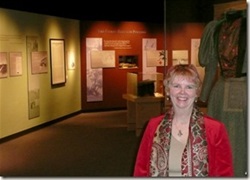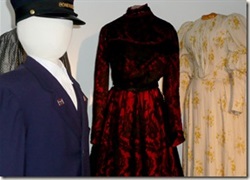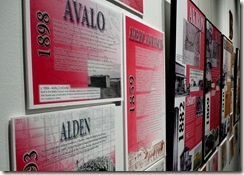Gathering History: Nancy Lynch of the City of Greeley Museums
Ask any little girl what she wants to be when she grows up and chances are she will rattle off a list of occupations including author, fashion designer and teacher. Nancy Lynch, Exhibits Curator for the City of Greeley Museums, grew up to be all three thanks to her artistic parents, her unique experiences as a child and her passion for all things historic.
 “While growing up, I discovered that my family was not like everyone else’s,” explained Lynch, “ I was the only one of my acquaintances whose mother painted murals on the kitchen wall, inlaid mother-of-pearl designs into musical instruments and decorated cookies using a palette of seven colors of icing.” Lynch’s mother, an antiques dealer, also sang and painted professionally.
“While growing up, I discovered that my family was not like everyone else’s,” explained Lynch, “ I was the only one of my acquaintances whose mother painted murals on the kitchen wall, inlaid mother-of-pearl designs into musical instruments and decorated cookies using a palette of seven colors of icing.” Lynch’s mother, an antiques dealer, also sang and painted professionally.
Lynch’s father, also an artistic soul, told stories and played guitar, spent weeks in his wood-shop creating musical instruments (he became renowned for making five-string banjos) including a guitar that he made with his daughter. “I did not go to Girl Scouts or church camp like my friends,” recalled Lynch. Instead, she attended folk music camp in the California Sierra Nevada’s and spent a summer in a Taos, New Mexico, with an artist colony.
A published writer when she was in high school, Lynch began to focus her creative energy in a new direction – historical textiles and design research for period theatrical productions. Her passion for Irish history and clothing led to her writing and illustrating a book in 1999 about ancient Irish pants. “The scholastic work received a small but passionate audience of historic garment devotees,” said Lynch.
Lynch, who attended the University of Kansas, chose history as one of her college majors. “…probably because I grew up wanting to know about my roots and loving stories about ancient times.
 “My family had been in the antiques business for generations, and I was always reading the histories of various pieces that we owned, were selling, or wanted to acquire. This led me to reading a lot of biographies and researching various time periods that I became interested in. If you find a piece of silverware that we do not use anymore, why did they have it before? What made the Victorians feel the need to have a fish fork? I love Art Nouveau designs from the late 1800s and early 1900s. What led to those designs of fluid asymmetrical organic beauty after the heavy and static designs of the earlier Victorian years? The more I learned the more I wanted to learn.”
“My family had been in the antiques business for generations, and I was always reading the histories of various pieces that we owned, were selling, or wanted to acquire. This led me to reading a lot of biographies and researching various time periods that I became interested in. If you find a piece of silverware that we do not use anymore, why did they have it before? What made the Victorians feel the need to have a fish fork? I love Art Nouveau designs from the late 1800s and early 1900s. What led to those designs of fluid asymmetrical organic beauty after the heavy and static designs of the earlier Victorian years? The more I learned the more I wanted to learn.”
Lynch took her knowledge of history and her passion for learning and spent several years working as a historic costumer and set designer for theater companies. “That is not a lucrative trade if you do not want to live in a large market like Los Angeles,” Lynch added. Lucrative trade or not, Lynch still enjoys bringing history to life.
“It has become my passion, “ she explained, “to recreate historically accurate presentations that also entertain, so people understand in a few moments what the world was like before today, thereby explaining a part of how we got where we are now.”
In 2000, Lynch began working for the City of Greeley Museums as the Lead Interpreter. In 2005, she achieved the position of Greeley Museums Exhibits Curator and now she designs and manages more than 30 building exhibits including the Centennial Village Museum, the Meeker Family Home, the Plumb Farm Learning Center, and all of the permanent and temporary exhibit galleries throughout the Greeley History Museum in downtown Greeley.
“Young and old are lost in their communities; (they are) not grounded in the now if they do not know the past” Lynch explained.
One of the many projects Lynch was involved with required the museum staff to spend a couple of years packing and moving artifacts from various storage facilities to clean temperature-controlled permanent storage. While moving those items, the crew located numerous artifacts and stories that related to towns across northeast Colorado. This inspired the team to spend three years pulling together those artifacts and stories for an exhibit titled Ghost Towns and Boom Towns.
 “We had so much information,” said Lynch, “we had to open the exhibit in stages over nine months.” The full exhibit is currently on display at the Greeley History Museum through September 2011. “Many stories of towns all over this area intertwine with others and yet are unique. We have uncovered fascinating tales of Native Americans, trappers, hunters, traders, swindler, farmers, railroaders, settlers, millionaires, cowboys, murderers, schoolmarms, ranchers miners and oil men; all adding to the histories of towns that make up Weld County from 1859 to today.” A smaller touring version of the exhibit is being hosted by the Weld County 150th Committee.
“We had so much information,” said Lynch, “we had to open the exhibit in stages over nine months.” The full exhibit is currently on display at the Greeley History Museum through September 2011. “Many stories of towns all over this area intertwine with others and yet are unique. We have uncovered fascinating tales of Native Americans, trappers, hunters, traders, swindler, farmers, railroaders, settlers, millionaires, cowboys, murderers, schoolmarms, ranchers miners and oil men; all adding to the histories of towns that make up Weld County from 1859 to today.” A smaller touring version of the exhibit is being hosted by the Weld County 150th Committee.
In addition to the museum exhibit, Lynch has worked diligently to put the history of Weld County towns together in a book Weld County Towns: The First 150 Years. “It will be a beautiful, color coffee-table sized book with lots of never-before-published images…” Lynch explained. The book is scheduled to be available by mid-summer.
In the meantime, Lynch will continue to research and write interpretive panels, publications, and historical persona re-enactments for the public to enjoy. She will continue to live out the dream of many little girls: to teach, to design and to write. And, as with everything in Lynch’s life, she will do it in her own unique way.
The information about the history of Weld County Towns was complied by Nancy Lynch and the staff at the Greeley Museums and made available to the 150th Anniversary web site.
You can visit the Greeley History Museum Wednesday through Friday from 8:30 a.m. to 4:30 p.m. and Saturday from 10:00 a.m. – 4:00 p.m. or you can visit their web site at https://greeleymuseums.com/locations/greeley-history-museum/.
If you are interested in learning more about the book, please contact Curtis Courtney at historybooks@juno.com.